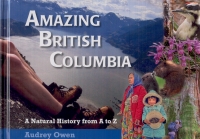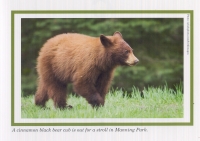| ________________
CM . . .
. Volume XVI Number 27. . . .March 19, 2010 
 |
Amazing British Columbia: A Natural History from A to Z.
Audrey Owen.
Gibsons, BC: Steppingstone Resources, 2009.
56 pp., hardcover, $19.95.
ISBN 978-0-9813476-0-8.
Subject Headings:
Natural history-British Columbia-Juvenile literature.
British Columbia-Juvenile literature.
English language-Alphabet-Juvenile literature.
Alphabet books.
Grades 3-5 / Ages 8-10.
Review by Gillian Richardson.
*** /4
|
| |
|

excerpt:
N, n
Cougar Brook growls through the land near Rogers Pass. Then it drops from sight. Underground, it dissolves the limestone rock.
There, the brook has made a maze of caves 6 km (3.7 miles) long. They are called the Nakimu (NAK-i-moo) caves.
In the caves, bacteria (bak-TEER-ee-a), limestone, and water combine to make moonmilk. The soft ooze covers the walls. Nakimu has the most moonmilk of any place in the world.
The first white people who visited the caves touched the walls. The caves still hold those 100-year-old handprints.
"When the phrase, 'amazing British Columbia' popped into my head, I thought, that's an alphabet book!" This idea sent Audrey Owen on a fascinating journey to uncover the many wonders of her home province and prompted her to share what she discovered in print and on the Internet. Within the eye-catching cover with its collage of BC images, alphabetically arranged facts appear in a clean layout of double-page spreads with upper and lower case letters, text, and photo. Facing the challenge of distilling copious research, the author found an imaginative solution in the creation of an interactive website, www.AmazingBritishColumbia.com, as a way for readers to extend their learning. While the book's main reading audience will be elementary school-aged students, much of the website would require adult reading skills.
 Some details of which many readers may be less aware include the Nakimu Caves, facts about Race Rocks and the Xeni Gwet'in people. However, choices such as alligator lizard, bear, kelp, octopus and woodpecker are described in general terms rather than with a specific BC connection. A helpful addition is pronunciation keys throughout the book, although a few more could have been included: fjord, Nisaqually, ungulates. There is no introduction to the book. Some details of which many readers may be less aware include the Nakimu Caves, facts about Race Rocks and the Xeni Gwet'in people. However, choices such as alligator lizard, bear, kelp, octopus and woodpecker are described in general terms rather than with a specific BC connection. A helpful addition is pronunciation keys throughout the book, although a few more could have been included: fjord, Nisaqually, ungulates. There is no introduction to the book.
Young readers at this level rely on precise comparisons to aid in understanding. The newborn bear that is "as big as a stick of butter" might be confusing to kids who are more likely to see butter in a block or tub. Likewise, the geoduck clam is described as being "as wide as a piece of writing paper" which comes in many sizes. The giant Pacific octopus that can weigh 270 kg (600 pounds) is declared to be simply "big"— tough to visualize without a specific association. By stating that glaciers "are also beautiful" the author has missed a chance to bring a memorable sensory image to her writing.
Thorough research, over six and a half years, was done in preparation for writing this book, and it shows in the wealth of details included. Only a couple of inaccuracies surfaced. The comment that Jade "is the world's toughest stone" may be disputed by the fact that diamond is highest on the hardness scale. The caption to a first-rate photo of the juvenile hairy woodpecker states, "he will lose the red mark on his head when he is an adult." The male actually has a red mark on the rear of his crown, rather than the top, while the female has no red patch. With respect to details, the reader is left to wonder about "Mrs. Davis" who "first called the dogwood our provincial flower," sold dogwood lapel pins and bought wool for socks to send to WWII soldiers. Intriguing information about a lady who deserves a full name.
Photos from many sources reinforce the text well. Animal shots are closeup and crystal clear. The aerial shot of Race Rocks shows the striking location on a tiny island. Less satisfying, for the letter P—Powell River—the photo of the dam and mill is a long distance shot showing little detail. For the letter E (earthquake), the match of text and photo is convincing, but the text focuses on tsunamis, and the photo shows the effects of a tsunami generated by an Alaskan earthquake in 1964. This choice might have been better for letter T (tsunami).
Amazing British Columbia is useful as a starting point for young readers who may need help navigating around the website to extend knowledge. For slightly older readers, S is for Spirit Bear (Sleeping Bear Press) offers a more inclusive BC experience.
Recommended.
Gillian Richardson is a freelance writer living in BC.

To comment
on this title or this review, send mail to cm@umanitoba.ca.
Copyright © the Manitoba Library Association. Reproduction for personal
use is permitted only if this copyright notice is maintained. Any
other reproduction is prohibited without permission.
NEXT REVIEW |
TABLE OF CONTENTS FOR THIS ISSUE
- March 19, 2010.
AUTHORS |
TITLES |
MEDIA REVIEWS |
PROFILES |
BACK ISSUES |
SEARCH |
CMARCHIVE |
HOME |

 Some details of which many readers may be less aware include the Nakimu Caves, facts about Race Rocks and the Xeni Gwet'in people. However, choices such as alligator lizard, bear, kelp, octopus and woodpecker are described in general terms rather than with a specific BC connection. A helpful addition is pronunciation keys throughout the book, although a few more could have been included: fjord, Nisaqually, ungulates. There is no introduction to the book.
Some details of which many readers may be less aware include the Nakimu Caves, facts about Race Rocks and the Xeni Gwet'in people. However, choices such as alligator lizard, bear, kelp, octopus and woodpecker are described in general terms rather than with a specific BC connection. A helpful addition is pronunciation keys throughout the book, although a few more could have been included: fjord, Nisaqually, ungulates. There is no introduction to the book.